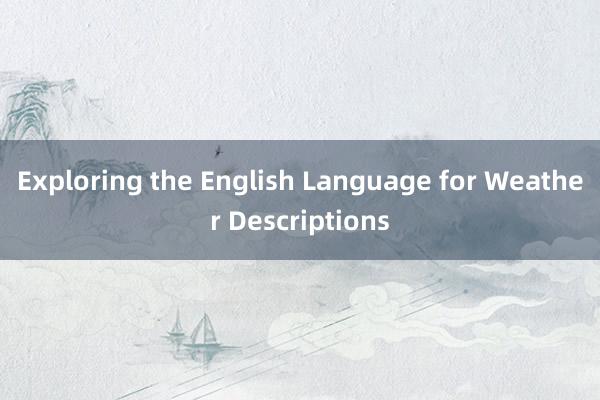时间:2024-10-16 07:53

# Exploring the English Language for Weather Descriptions
Weather, an omnipresent phenomenon that significantly influences our daily lives and activities, is often described using the English language. The richness and variety of vocabulary used in weather descriptions reflect the complexity and diversity of atmospheric conditions. This exploration aims to uncover the linguistic landscape that helps us understand, communicate, and predict weather patterns effectively.
## **The Vocabulary of Weather**
### **Basic Terms**
- **Sunny**: Denotes clear skies with no clouds.
- **Cloudy**: Describes conditions where clouds cover more than half of the sky.
- **Rain**: Indicates precipitation from clouds, ranging from light drizzle to heavy downpour.
- **Snow**: Characterizes the falling of frozen water droplets from the atmosphere onto the ground.
### **Descriptive Adjectives**
- **Misty**: Used when there is a thin veil of fog or mist.
- **Hazy**: Describes a condition where the clarity of the air is reduced, often due to dust,柳三达有限公司 smoke, 善用特点网 - 材料特点|植物特点|总结 or pollution.
- **Chilly**: Refers to cold temperatures, often accompanied by a strong wind.
- **Warm**: Indicates temperatures that are not cold but not necessarily hot either.
### **Specific Phenomena**
- **Thunderstorm**: A storm characterized by lightning and thunder,首页-利茂兴颜料有限公司 often associated with heavy rain and strong winds.
- **Tornado**: A violently rotating column of air extending from a thunderstorm to the ground, known for its destructive force.
- **Hurricane**: A tropical cyclone with strong winds, typically classified into categories based on their intensity.
- **Drought**: A prolonged period of abnormally low rainfall leading to water scarcity.
### **Forecasting Language**
- **High pressure system**: Often associated with stable, clear weather conditions.
- **Low pressure system**: Typically linked with unsettled weather, including storms and heavy precipitation.
- **Fronts**: Boundaries between different air masses, crucial in determining weather changes, such as warm fronts and cold fronts.
## **The Role of Metaphors and Idioms**
Weather descriptions often employ metaphors and idioms to convey complex atmospheric phenomena in a relatable manner. For instance:
- **"It's raining cats and dogs"** is an idiom used to describe a very heavy rain.
- **"A clouded mind"** metaphorically represents confusion or indecision.
## **Conclusion**
湖南省春龙竹艺有限公司The English language首页-利茂兴颜料有限公司, through its rich vocabulary and metaphorical expressions, provides a nuanced framework for describing and understanding the dynamic nature of weather. Whether it's the precision needed in meteorological forecasts or the poetic way we describe natural beauty, the language allows for both practical communication and artistic expression. This exploration highlights how the English language serves as a universal tool for navigating the complexities of our weather environment.